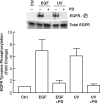Epidermal growth factor receptor is a critical mediator of ultraviolet B irradiation-induced signal transduction in immortalized human keratinocyte HaCaT cells
- PMID: 16936259
- PMCID: PMC1698809
- DOI: 10.2353/ajpath.2006.050449
Epidermal growth factor receptor is a critical mediator of ultraviolet B irradiation-induced signal transduction in immortalized human keratinocyte HaCaT cells
Abstract
Epidermal growth factor receptor (EGFR) is a critical mediator of several types of epithelial cancers. Skin cancer arising from exposure to ultraviolet B irradiation (UVB) from the sun is a prominent form of human cancer. Recent data indicate that in addition to cognate ligands, EGFR is activated by UVB irradiation. We used pharmacological and genetic approaches to investigate the function of EGFR in mediating UVB-induced signal transduction in human skin keratinocyte HaCaT cells. Pharmacological inhibition of EGFR tyrosine kinase significantly inhibited UVB-mediated induction of ERK, p38, and JNK MAP kinases, and their effectors, transcription factors c-Fos and c-Jun. Inhibition of UVB activation of EGFR also suppressed activation of AKT-, PKC-, and PKA-dependent signal transduction pathways. B82 mouse L cells devoid of EGFR were used to further investigate EGFR dependence of UVB-induced signal transduction. UVB failed to induce ERK, and JNK activation was reduced 60% in B82 cells compared to B82K+ cells, which express EGFR. In addition, UVB induced both c-Fos and c-Jun proteins in B82K+ cells, whereas neither were induced in B82 cells. Taken together, these data demonstrate that EGFR is required for UVB-mediated induction of multiple signaling pathways that are known to mediate tumor formation in skin.
Figures






Similar articles
-
Differential stimulation of ERK and JNK activities by ultraviolet B irradiation and epidermal growth factor in human keratinocytes.J Invest Dermatol. 1997 Jun;108(6):886-91. doi: 10.1111/1523-1747.ep12292595. J Invest Dermatol. 1997. PMID: 9182816
-
EGFR activation confers protections against UV-induced apoptosis in cultured mouse skin dendritic cells.Cell Signal. 2008 Oct;20(10):1830-8. doi: 10.1016/j.cellsig.2008.06.010. Epub 2008 Jun 24. Cell Signal. 2008. PMID: 18644433 Free PMC article.
-
Involvement of EGF receptor activation in the induction of cyclooxygenase-2 in HaCaT keratinocytes after UVB.Exp Dermatol. 2003 Aug;12(4):445-52. doi: 10.1034/j.1600-0625.2003.00101.x. Exp Dermatol. 2003. PMID: 12930301
-
The UV (Ribotoxic) stress response of human keratinocytes involves the unexpected uncoupling of the Ras-extracellular signal-regulated kinase signaling cascade from the activated epidermal growth factor receptor.Mol Cell Biol. 2002 Aug;22(15):5380-94. doi: 10.1128/MCB.22.15.5380-5394.2002. Mol Cell Biol. 2002. PMID: 12101233 Free PMC article.
-
Involvement of MAP kinase signal transduction pathway in UVB-induced activation of macrophages in vitro.Immunol Lett. 2003 Dec 15;90(2-3):123-30. doi: 10.1016/j.imlet.2003.08.008. Immunol Lett. 2003. PMID: 14687713
Cited by
-
Luteolin suppresses UVB-induced photoageing by targeting JNK1 and p90 RSK2.J Cell Mol Med. 2013 May;17(5):672-80. doi: 10.1111/jcmm.12050. Epub 2013 Apr 4. J Cell Mol Med. 2013. PMID: 23551430 Free PMC article.
-
Photoprotective Effects of Cycloheterophyllin against UVA-Induced Damage and Oxidative Stress in Human Dermal Fibroblasts.PLoS One. 2016 Sep 1;11(9):e0161767. doi: 10.1371/journal.pone.0161767. eCollection 2016. PLoS One. 2016. PMID: 27583973 Free PMC article.
-
Niacin protects against UVB radiation-induced apoptosis in cultured human skin keratinocytes.Int J Mol Med. 2012 Apr;29(4):593-600. doi: 10.3892/ijmm.2012.886. Epub 2012 Jan 12. Int J Mol Med. 2012. PMID: 22246168 Free PMC article.
-
Persistent polar depletion of stratospheric ozone and emergent mechanisms of ultraviolet radiation-mediated health dysregulation.Rev Environ Health. 2012;27(2-3):103-16. doi: 10.1515/reveh-2012-0026. Rev Environ Health. 2012. PMID: 23023879 Free PMC article. Review.
-
1,8-cineole prevents UVB-induced skin carcinogenesis by targeting the aryl hydrocarbon receptor.Oncotarget. 2017 Nov 20;8(62):105995-106008. doi: 10.18632/oncotarget.22519. eCollection 2017 Dec 1. Oncotarget. 2017. PMID: 29285309 Free PMC article.
References
-
- Egeblad M, Werb Z. New functions for the matrix metalloproteinases in cancer progression. Nat Rev Cancer. 2002;2:161–174. - PubMed
-
- Itoh Y, Nagase H. Matrix metalloproteinases in cancer. Essays Biochem. 2002;38:21–36. - PubMed
-
- Pupa S, Menard S, Forti S, Tagliabue E. New insights into the role of extracellular matrix during tumor onset and progression. J Cell Physiol. 2002;192:259–267. - PubMed
-
- Zheng Z, Chen R, Prystowsky J. UVB radiation induces phosphorylation of the epidermal growth factor receptor decreases EGF binding and blocks EGF induction of ornithine decarboxylase gene expression in SV-40-transfomed human keratinocytes. Exp Dermatol. 1993;2:257–265. - PubMed
-
- Sachsenmaier C, Radler-Pohl A, Zinck R, Nordheim A, Herrlich P, Rahmsdorf H. Involvement of growth factor receptors in the mammalian UVC response. Cell. 1994;78:963–972. - PubMed
Publication types
MeSH terms
Substances
Grants and funding
LinkOut - more resources
Full Text Sources
Other Literature Sources
Medical
Research Materials
Miscellaneous

